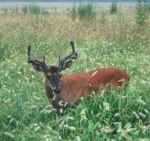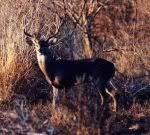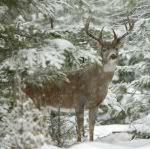 Spring
SpringSpring is the season of new beginnings. The big event is the birth of fawns in late May or June. Triggered by increasing amounts of daylight, bucks begin to grow new antlers. Spring is a tranquil time when deer relax and replenish their bodies from the long, harsh winter.
Come spring, some whitetails must reacquaint with their environment. Northern deer begin the trek back toward their warm-weather range. This may take a few days or a few weeks. Deer usually inhabit the same winter and summer ranges all their life. However, favorable spring weather allows deer to explore and extend their home ranges.
Does and bucks must also readjust their social relations. Some deer didn't survive the previous fall and winter-they were shot by hunters, hit by cars, killed by predators or succumbed to harsh weather. Buck groups may find themselves without a dominant buck. Although they are passive during the spring, bucks still have ways of establishing dominance. Since bucks lack large, hard antlers, they use their front feet to spar with one other.
A few days before giving birth to fawns, does return to familiar fawn-rearing areas. Since does have some control over when they birth, they spend time looking for a suitable area away from predators. A doe occupies her secret spot for about 3 hours after dropping one or 2 fawns, giving the young time to associate with their mother. Fawns learn to walk and follow mama quickly.
Does are alert and aggressive as they protect their fawns. They ward off predators and even other deer. Does frequently leave fawns alone as they venture out to feed. If a fawn senses danger it utters a bleat or bawl. The mother comes running.
Deer enjoy a wide variety of foods in spring. Much of the foliage is rich in nutrients-a welcome change to the twigs deer were forced to eat the previous winter. The nutrients help replenish a deer's body. Pregnant does increase their food intake.
Deer also consume a large amount of salt during the spring. Why is not clearly understood. Some researchers believe that the increased nutrients in a deer' s diet cause a sodium loss through urination. Thus, deer replace it with salt.
Deer shed their thick winter coats in spring. This process is called molting, and it occurs again prior to winter. Molting is thought to be caused by many factors, including temperature and light.
 Summer
SummerSummer is the lazy season for deer. Life continues as it was in the spring. Fawns grow and learn about the world from their mothers, which they now recognize by scent. The testosterone level of bucks is low, so males aren't all that active. Bucks spend the summer learning about other bucks in their herd and storing fat for the winter.
The antlers of a buck become prominent and covered in soft velvet. Without hardened antlers, bucks spar for dominance with their forelegs. Some researchers believe that the dominant hierarchy is established in the summer.
Summertime is not without its problems. Droughts can hit on the local or regional level, impacting the whitetail's food supply. Some deer share summer range with livestock and compete for food. But for the most part, these things don't cause deer too much trouble.
 Fall
FallAutumn brings a distinct change in the whitetail's behavior. The passiveness of spring and summer is gone, replaced by the frenzy of the breeding season. Mature bucks become aggressive and roam widely in search of does.
The rut, or the whitetail's breeding season, occurs in the fall. The time before mating, or the early pre-rut, is characterized by groups of does, bucks and fawns grazing together. Bucks mingle with does to showboat their new antlers.
Throughout the pre-rut, the does' reproductive organs adapt to handle breeding and pregnancy. Less daylight triggers an increase in the bucks' testosterone, the hormone responsible for, among other things, antler maturation. Once antlers harden, the velvet that covers them dies and dries up. Older bucks generally rub off the velvet before younger males do.
To establish dominance in a hierarchy, bucks engage in a behavior called sparring. Two animals lock their antlers and push until one buck backs down, thus yielding dominance to the other buck. It should be noted that sparring is not fighting. Once a buck gains dominance, he maintains his position in the hierarchy by staring down other bucks. If another buck rises to the challenge, the two deer engage in a fight, clashing antlers and pushing until one buck backs down.
In fall, a buck uses "signposting". He scrapes and rubs, leaving his scent on the ground and on trees for does and other bucks to smell. When a buck and doe hook up, they chase before mating. After mating, a buck may graze with a doe for a while before darting off to find another mate.
The rut leaves a buck frail and tired. Sometimes a dominant buck is so weak that he can barely survive the winter. This gives younger bucks a chance to breed does that come into late estrus, generally in December. Bucks use up testosterone during the breeding season, and this causes their racks to fall off in the winter.
Fall is a time of new experiences for fawns. They watch and learn all the social interaction and posturing within a herd. Fawns get used to seeing bucks with full racks, and witness fights and mating.
In the fall, deer seek out foods rich in carbohydrates. Acorns, beechnuts, pecans, apples and other soft and hard mast, in addition to crops, help pack on fat that carry deer through the rut and winter.
 Winter
WinterThe effects of winter on deer are much greater in the North than in central and southern states. In order to escape the cold and snow, some deer migrate 50 miles or more to suitable winter range. Food supplies are often scarce. Deer survive on whatever twigs or brush they can find. Some older bucks, worn out from the rut, may die. Doe and fawns may perish from malnutrition or predation. The survival of a deer depends primarily on how well it prepared during the other three seasons. One good thing: The metabolism of whitetails slows down in the winter, so the animals don't have to eat as much to keep their bodies going.
The buck's thick winter coat keeps him warm. The dark-gray color helps absorb the sun's heat. In extreme cold, a deer tightens its skin muscles and the coat hairs stand on end. This traps air near the skin's surface, insulating a deer and keeping it warm. This process is called piloerection.
During winter, bucks once again form social groups. Younger deer learn how to survive the harsh conditions from the older deer in the herd.
Many biologists believe that lack of nutrition, not cold weather, depletes whitetails. In many areas deer may go days without eating. In this case, deer derive their energy from fat reserves that they built in the fall. Nowadays in farming areas, many deer stay healthy by feeding on leftover grains.
The struggle for survival forces many deer to congregate in one area, called a "deer yard". A yard is located where there is some food around, and where the temperature is relatively warm--for example on a south-facing slope. Regardless of social grouping, deer congregate in a yard. Here, fights can break out over the tiniest morsel of food. Fawns usually suffer. They can't reach food on high branches, and bigger, older deer bully them.

No comments:
Post a Comment